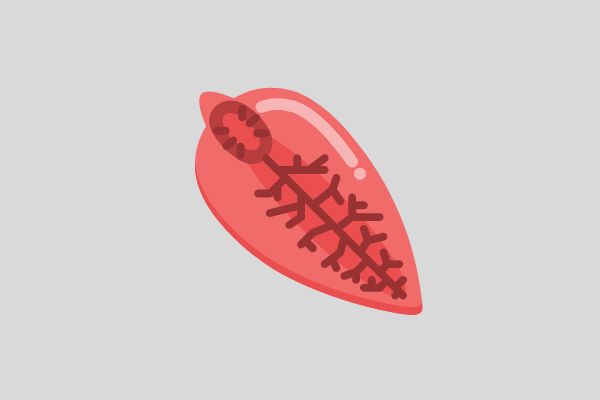Large intestinal fluke in Vietnam disease: What agents are the sources of infection? What symptoms will the patient experience?
What causes large intestinal fluke infection?
Pursuant to Section 1 of the Guidelines issued together with Decision 1636/QD-BYT in 2022, the following guidelines are provided:
"first. OUTLINE
Large intestinal fluke is a parasitic disease that is transmitted between humans and animals. Patients infected with large intestinal flukes in the small intestine, especially in the duodenum, the symptoms are caused by local ulceration or systemic toxicity, diarrhea often alternates with constipation, vomiting and loss of appetite. In some cases, there is a large number of flukes that can cause acute intestinal obstruction, facial edema, abdominal wall edema, leg edema, and ascites.
Large intestinal fluke is widespread in many countries, especially some Asian countries. In Vietnam, large intestinal fluke has been detected in 16 provinces and cities.
1.1. Agent
Large intestinal fluke is caused by Fasciolopsis buski, which is one of the largest species of flukes that cause disease in humans.
1.2. Inoculum
Reservoir: Pigs and humans are the main hosts of adult intestinal flukes; Dogs are the less common primary host.
Incubation period: Large intestinal fluke eggs appear in the stool about 3 months after infection.
Transmission period: Lasts when eggs are excreted in the feces, if untreated, egg discharge lasts for 1 year. No direct person-to-person transmission.
1.3. Mode of transmission
Humans and pigs are infected by eating raw vegetables in the water that are infected with large intestinal fluke cysts.
1.4. Infectiousness and immunity
Everyone can become infected with large intestinal flukes, immunity is not stable and possible re-infection.”
Accordingly, the cause of the large intestinal fluke disease is because humans eat infected pigs or vegetables in the water that are infected with large intestinal fluke cysts.
Anyone can get fascioliasis, regardless of age or sex. In addition, fascioliasis is immunologically unstable and re-infection is possible.

Large intestinal fluke in Vietnam disease: What agents are the sources of infection? What symptoms will the patient experience? (Image from the internet)
What are the symptoms of a large intestinal fluke in Vietnam?
Pursuant to Section 2 of the Guidelines issued together with Decision 1636/QD-BYT in 2022, the following guidelines are provided:
"2. CLINICAL SYMPTOMS
2.1. Clinical symptoms
Most patients are usually asymptomatic.
- In case of severe infection, symptoms may include: abdominal distention, diarrhea, nausea, allergic reactions, facial edema, leg edema and possibly anemia.
2.2. Clinical form
2.2.1. Light body
Patients usually have no clinical symptoms.
- Or the patient has mild symptoms: fatigue, mild anemia.
2.2.2. Average body
- Body as a whole: fatigue, nausea, vomiting, loss of appetite, weight loss.
- Abdominal pain: usually pain in the lower abdomen, abdominal pain accompanied by diarrhea and can occur with severe pain. Abdominal distension, especially in children.
- Diarrhea: can last for several days. Abdominal pain and diarrhea occur erratically, possibly constipation. The stools are loose, not bloody, but have a lot of mucus and contain a lot of undigested food.
2.2.3. Heavy body
- If infected with a large number of intestinal flukes and if not treated, the disease will progress to a severe stage.
- Body as a whole: body weakness.
- Severe abdominal pain and digestive disorders.
- Edema of the face, edema of the abdominal wall, edema of the legs, possibly of the whole body; pericardial effusion, pleural effusion, ascites.
- In case of infection with a large number of intestinal flukes, it is possible to vomit flukes."
Accordingly, patients with large intestinal fluke in Vietnam are mostly asymptomatic.
Depending on the severity, mild or moderate infection, the victim may show different clinical symptoms.
For patients infected with large intestinal fluke in Vietnam in severe form will appear physical weakness, abdominal pain and severe digestive disorders. In case of infection with a large number of flukes, the patient may vomit flukes.
What is the life cycle of large intestinal fluke infection?
Pursuant to Section 1 of the Guidelines issued together with Decision 1636/QD-BYT in 2022, there are guidelines on the infection cycle of large intestinal flukes as follows:
(1) Large intestinal fluke eggs are excreted in the feces of the main host.
(2) Eggs develop into Miracidia hairy larvae in the aquatic environment.
(3) Miracidia enters the first intermediate host, the snail.
(4) In Miracidia snails develop into different stages (4a, 4b, 4c), the final stage is the Cercariae tail larva, which leaves the snail host.
(5) Cercariae tail larvae swim freely in water, attach to aquatic plants and develop into metacercariae.
(6) Metacercariae larvae attach to aquatic plants.
(7) The main host is a mammal or a human that becomes infected by accidental ingestion of aquatic plants containing live Metacercariae. In this host, Metacercariae exits the cyst in the duodenum and attaches to the intestinal wall. There, they develop into adult flukes; This process takes about 3 months.
(7) Adults (20 to 75 mm x 8 to 20 mm) have a lifespan of about 1 year.
Accordingly, the infection cycle of large intestinal fluke infection will include 7 stages described in the content of the guidelines above.
LawNet
